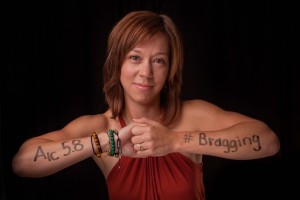
By Smarty Guest Blogger, Jessica Lynn-Lato
I love everything about autumn – cooler weather, football games and the leaves changing colors. While it’s my favorite time of year, it’s also particularly important to me because November is National Diabetes Awareness Month and I have type 1 diabetes (T1D).
T1D is an autoimmune disease in which a person’s immune system suddenly attacks and destroys the insulin-producing cells of the pancreas.
I was 28-years-old, married and pregnant with our first child when I was diagnosed with T1D. My doctors told me that I did not have gestational diabetes but rather the “bad” kind, meaning it won’t go away until a cure is found. I knew next to nothing about T1D. I was given a crash course in T1D disease management. In a matter of a few hours, my husband and I learned how to test my blood sugar with finger pricks and a glucose meter and what range my levels should be at certain times of the day (first thing in the morning, before and after meals, bedtime, during exercise, etc). We learned to read food labels, count carbohydrates, calculate needed insulin to cover the food I ate and how to dose and inject insulin. It was all very scary and overwhelming.
Dangerous high or low blood sugars are a constant threat, and despite a person’s best efforts, serious complications can arise.
Living with T1D is 24 hours a day, 7 days a week. There are no days off. I must think about it constantly. I test my blood sugar 10-15 times a day (including in the middle of the night). I wear an insulin pump 24/7 (I can disconnect it briefly to shower). It is connected to my body with tubing and a port-like site. Every time I eat something I “tell” the pump how many carbs I am going to eat and then the pump calculates how much insulin is needed and sends it into my body. Every three days I have to change the site on my body where the pump is attached. I move it to different parts of my body so that I don’t develop scar tissue and infections. Eating and dosing insulin is not an exact science. There are many things that affect your blood sugar including exercise, stress, illness and hormones. So often I have low blood sugar and feel like my battery is dying and I desperately need a re-charge. I get sweaty, confused and emotional and I can’t think clearly. I have to carry glucose tablets or sugary candy (Swedish Fish) with me at all times. Often, a low blood sugar is followed by a high blood sugar which comes with a host of other symptoms. Despite my best efforts, it’s a constant roller-coaster. I have had some very serious low blood sugars that hit me while I was asleep. One incident happened very early on Christmas morning. My husband awoke to find me having a seizure. He knew immediately that it was a severe hypoglycemic episode (low blood sugar) and he injected me with emergency glucagon (like sugar), dialed 911, and saved my life.
There is currently no cure and T1D requires a lifetime dependence on insulin.
It’s been 17 years since my diagnosis. I’ve had a few bumps along the way, but my outlook is that I am stronger than this disease. I work very hard to take good care of myself. Every four months I visit my endocrinologist and he tests my A1c. This is a blood test that averages my blood sugars over the previous three months. The goal is to get an A1c below 7.0. When this photograph was taken, I had just been to see my doctor and my A1c was 5.8. Thrilled that my hard work had paid off, I decided that was the message I wanted to share in my photograph.
T1D strikes children and adults at any age and there is nothing a person can do to prevent it.
As one of the most impactful volunteer-driven organizations in the world, JDRF depends on volunteer passion to drive our mission and talent to keep us going. JDRF has volunteer opportunities with events, community outreach, government advocacy and office support. Email asutton@jdrf.org to learn more.
I volunteer with JDRF, the largest funder in the world of T1D research. Volunteering with the JDRF Greater Western Carolinas Chapter fills me up in ways that I cannot describe. JDRF is made up of families and caregivers of children and adults living with T1D and others that are passionate about funding the research that is necessary to create new treatments, technologies and ultimately a cure for T1D. Please help us by donating to JDRF during National Diabetes Awareness Month and together we can turn Type One into Type None. Join us today at www.jdrf.org.
Mark your calendar
Please join us for our upcoming JDRF Hope Gala, Saturday, November 14th at the Westin Charlotte. The magical evening will include cocktails, dinner, silent and live auction, Fund A Cure and an After Party. We will celebrate the extraordinary generosity and dedication of our volunteers, sponsors, donors and patrons including Bank of America as our honoree, that are helping JDRF turn Type One into Type None. Please visit www.hopegalacharlotte.com for additional information.



